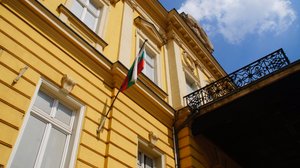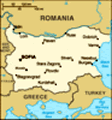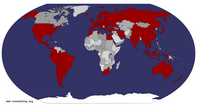Advertisement
Published: September 30th 2016

 National Art Gallery
National Art Gallery
The National Art Gallery is housed in the former royal palace. When Bulgaria wanted to become a kingdom again after Ottoman rule, it had no heir - and so it simply imported one from Austria (Alexander Battenberg).It seems that all roads lead through Skopje and I made my way back there for a third time to get a bus to Sofia. Thanks to the political situation around borders, there is no direct bus from Pristina to Sofia as you would have to go through Serbia.
At the bus station in Pristina, I met Eric, an American going the same way. Once we got to Skopje, we then met Frenchman Pierre, who was at the same hostel as me in
Pristinaand was also making his way to Sofia. So suddenly I had a crew which to be honest, is nice to have on long journeys.
The Bulgarian countryside is actually pretty nice. I'm not sure what I was expecting, but I was impressed by the pretty plains, rolling hills and green forests, which look great for hiking.
Once in Sofia, we lost Pierre who was staying at another hostel but Eric followed me to Hostel Mostel, a rather large and lively hostel - and perhaps should've been nicknamed The Sausage Hostel for that particular night - where I once again bumped into Londoner Jamie who I had hung out with in Pristina. I had gone off the

 Ministry Council Building & Former Communist Party House
Ministry Council Building & Former Communist Party House
Both buildings are typically communist in style; the Former Communist Party House even resembles one of Stalin's "Seven Sisters" in Moscow.Balkan backpacker trail a little with my travails in Greece but it definitely feels like I have got back onto it since getting to Kosovo.
There is a nightly pub crawl at Hostel Mostel and though I had told myself that I'd rest after a long journey of seven-and-a-bit hours from Pristina, the energy of the hostel and Eric and Jamie's keenness to go out typically sucked me in and so I gave myself the old line of "I'll come along for a couple..."
Which of course is never "just a couple". We went to some funky bars including one that was reminiscent of a bar I went to in
Berlin which had its entrance through a dodgy-looking lobby and up a dodgy-looking flight of stairs. The second bar had a nice setting in the middle of a park and the third was a cellar bar reminiscent of similar bars I have visited in
Kraków,
Budapest and
Prague. We then finished the night with some karaoke - we didn't unfortunately get to sing on stage before the bar closed but we were treated to a blonde Bulgarian girl who did probably the best Adele impression of "Hello" that I

 St Alexander Nevski Cathedral
St Alexander Nevski Cathedral
I can't quite remember the whole story but I believe that the cathedral was built in honour of a/some Russian(s) but needed to be named after a saint - and thus Alexander Nevski was chosen as it was the Russian(s)'s favourite saint.have ever witnessed.
As well as some funny conversations with my fellow (male) hostellers, the thing that struck me most that night was how bloody cheap everything was. Half-litres of beer would put you back just 1.35€ (approximately) and a decent and decently-sized post-drinking/karaoke munchie burger was just 1.85€. The difference between here and say, Macedonia and Albania is that Sofia seems more like your lively, pretty and more typically European city than most of the other places I have visited recently. It felt like I was somewhere like Prague or Budapest again and I was looking forward to what else Sofia had in store for me.
The next morning I went on the free walking tour which is always a great way to see some of the sights while learning a bit about where you are at the same time.
A quick run down on Bulgarian history; originally inhabited by the ancient, pre-Roman Thracians, Bulgaria was then ruled by the Romans until the latter end of the 7th century when the first of two Bulgarian empires was established. But for a brief period under Byzantine rule, Bulgaria ruled itself for almost 800 years before succumbing to the

 National Theatre
National Theatre
The theatre is officially named after prominent writer Ivan Vazov.Ottomans towards the end of the 14th century. This lasted until 1878, when Bulgaria liberated itself following the Russo-Turkish War. Like every other country in the Balkans, things then got really messy both during and between WWI and WWII and every other country in the Balkans, turned to Communism in the second half of the 20th century. Bulgaria adopted Communism with gusto and at one stage even proposing to join the Soviet Union. Communism fell in 1989 and since then, there has been a gradual transition to becoming a truly free democracy with Bulgaria joining the EU in 2007.
As for the walking tour itself, it was popular, informative and enthusiastically delivered - especially regarding Bulgaria's history, of which the Roman part is still visible. Roman buildings and foundations are on permanent display beneath the current modern city of Sofia, which were discovered during excavations when building the city's metro system.
I also learnt that Bulgaria was on the side of Nazi Germany during WWII, although they had little active participation. They had hoped to remain neutral for the duration of the war but due to their central geopolitical position, could not realistically remain so and they joined the

 Banya Bashi Mosque & Sveta Petka Church
Banya Bashi Mosque & Sveta Petka Church
In the background is the only currently functioning mosque in Sofia, a remnant from Ottoman times; in the foreground is the Sveta Petka Church which is partly underground as during Ottoman times, churches could not be taller than mosques.Axis Powers under the promise that they would gain Greek territories. Procrastination is a favourite Bulgarian pastime according to our tour guide and it was this procrastination that saved the lives of thousands of Bulgarian Jews who the Germans demanded be sent to concentration camps. The Bulgarian government took their time over the request and eventually with so many other things to worry about, the Germans forgot about their demand and the war soon ended. With the onset of communism, the majority of Bulgarian Jews emigrated to Israel where they still maintain strong links with the country they left. Israel officially thanked Bulgaria for its role in saving Jews from the Nazis.
Lateness is another common Bulgarian trait according to our tour guide and it was what saved Tsar Boris III who was due to attend a funeral in Sofia's St Nedelya Church in 1925. Communist terrorists blew up the church during the service, which nevertheless killed 150 people.
It was a good walking tour though I'd probably still rate other tours I have done above it. While it was good to learn a bit about Bulgarian history, I felt that it perhaps lacked any of the compelling insights which

 Sredets
Sredets
Trendy part of town with hip eateries - it was in this part of town that the free food tour took place.I've gained from other tours.
There were some Spanish girls from Valencia in my walking tour group who then joined me on a free food tour of Sofia that afternoon - so I got to practice my Spanish a little! I was a bit nervous about how rusty my Spanish has become however and inevitably I received the an ego blow of them replying to me in English! Their English was much better than my Spanish, mind. Having been better at speaking than understanding, after a lack of recent practice I now find that things have been switched the other way, as words and conjugations come to me much slower. Being able to practice with someone with a lot of patience would be perfect!
I have never done a free food tour before and indeed the people conducting the tour claim that this is the only free food tour in the world! So now I would be able to learn even more about Bulgaria's history through one of my favourite pastimes; food!
The tour stopped at three rather trendy eateries in a fairly hipster part of town and we ended the tour at a traditional restaurant. We tried

 Sofia Scene
Sofia Scene
I love cities with tram lines, it gives them character. Sofia itself was definitely one of the more characterful cities that I have visited in the Balkans and gave off that pretty 'European city' vibe.and learned something different at each place. Food we sampled included a nice yoghurt spread,
banitsa (the Bulgarian take on
burek),
mekitsa (a deliciously sweet hot, fried bread with icing sugar similar to
churros or a donut), some cheese spreads and some local wine. The
mekitsa was probably the best followed by the
banitsa.
The food tour shed some light on Bulgaria's culinary ethnography; wheat came from agriculture established by the Thracians; spices came from the Ottoman Empire; milk that turned into cheese and yoghurt after being carried for long periods in leather pouches, came from nomads who trekked across to Bulgaria from present-day Afghanistan and Pakistan.
Overall it was an interesting perspective on Bulgarian culture although the food wasn't especially special. It wasn't really much either - I wasn't expecting a whole meal but I was expecting a bit more than what was served. Would like to have tried some cooked dishes too. But I guess you can't expect too much of a tour giving you free food!
Predictably, I went on the pub crawl again that night. Having only had three-and-a-half hours sleep the previous night, I needed to pre-game with coffee rather than alcohol. I'd built

 Inside St Alexander Nevski Cathedral
Inside St Alexander Nevski Cathedral
You were meant to pay 5€ to take pictures inside the cathedral, but I managed to sneak this one for free.up a bit of a crew by now, for some of whom it was their last night in Sofia. So I
had to go out, really. It was fun however, hanging out with Eric, Jamie and others over a few more beers.
Road 66 was the first place we visited, a sort of Irish/biker bar where I got some pointers for visiting Japan from an American girl who had lived there. I got to practice my Spanish with yet more Spaniards at the next bar, which was down an alley and had a pirate theme to it. It was there also, where I got chatting to a rugby-playing American girl.
It was the pub crawl guide's last night working at the hostel and the guy loved a sing-a-long; so I think that it wasn't coincidental that the karaoke bar we frequented the previous night happened to be right next to the pirate bar. This time, fuelled by Dutch courage - real Dutch courage in the case of Gilles the Dutchman - we did get to sing. I sure hope the video of Gilles and I singing Human League's "Don't You Want Me" doesn't ever surface although I was rather more

 Foyer Of St Alexander Nevski Cathedral
Foyer Of St Alexander Nevski Cathedral
Almost as pretty on the outside as it is on the inside.satisfied with my rendition of The Eagle's "Hotel California". Our group effort on Papa Roach's "Last Resort" wasn't so successful. The night ended like the previous one did - with a massive burger (with fries in it!) on the way back to the hostel.
Urgh. I'm sick of being hungover. I skipped breakfast because I was just too tired and didn't get going until about 2pm.
I used the half-day I had left to go inside the Aleksander Nevski Church, which was charging 5€ to take photos inside! It is quite impressive but I still reckon the
Church Of Our Saviour Of Spilled Blood is still the most impressive church interior I have ever seen with
St Peter's Cathedral a close second. I managed to sneak a couple of photos before being informed about the charge - which I obviously refused to pay before leaving.
I then tested out Sofia's efficient metro system to get to the Museum Of Socialist Art. It was full of propaganda, statues and busts promoting an ideology with noble intentions but is practically unworkable. The propaganda video on display made me cringe. It was otherwise an interesting visit to learn about the irony of how a system that rejects individual expression, ended

 Sofia Central Mineral Baths
Sofia Central Mineral Baths
The water from the mineral springs that supply the bath house is supposed to be able to mend a broken heart.up creating parameters - and in turn its own art form - within which one was supposed to express themselves.
Walking around the city I did appreciate the relative order, prettiness and sophistication of Sofia having recently visited the likes of
Tirana,
Skopje and Pristina which were all drab, bland and relatively undeveloped in comparison. Sadly, I was bizarrely relieved to see the likes of McDonald's, Burger King and Starbucks again; it was much like how I felt after Cuba, having missed the familiarity of Western surroundings.
The city has definitely been a pleasant surprise - especially considering how cheap everything is. Another surprise is the fact that drivers stop for pedestrians here! It is certainly a change from the wild west driving rules in the rest of the Balkans!
The more I travel and the more beggars and homeless that I see, the more I think that it is inequality rather than general poverty that leads to people on the streets. In Cuba, Albania and Kosovo, I found that I hardly saw any homeless people - I see more on the streets of London and indeed here in Sofia. My theory is that in countries like Cuba

 Palace Of Justice
Palace Of Justice
The main courthouse of Sofia. Incidentally, the lion is Bulgaria's main symbol and their currency is called the lev - or in English, the lion. There have never been real wild lions in Bulgaria, of course.and Albania, yes, they are relatively poor country but everyone is more or less at the same level and that everyone at least has enough to get a roof over their heads; what little wealth is available, is more evenly distributed so that no-one is too worse off. In a country with a chasm between the haves and have-nots, the poorest have much less. Sadly here in Bulgaria, you have beggars asking for change outside the Cartier shop - before security moves them on.
The one last thing I wanted to do before leaving Sofia was to visit the much hyped National Archaeological Museum. At 10
leva (5€), it was expensive but probably worth it considering the stuff they had in there which included brilliantly preserved Thracian busts, masks and helmets, the mandible of an extinct bear, loads of Roman friezes and more helmets and weapons that pre-dated even the Thracians.
And indeed the National Archaeological Museum was the last thing I did in surprisingly sophisticated Sofia. Later that afternoon I left Bulgaria's modern metropolis for its medieval capital; Veliko Tarnovo!
до скоро (do skoro),
Derek
Advertisement
Tot: 0.156s; Tpl: 0.021s; cc: 11; qc: 32; dbt: 0.0598s; 1; m:domysql w:travelblog (10.17.0.13); sld: 1;
; mem: 1.2mb























































